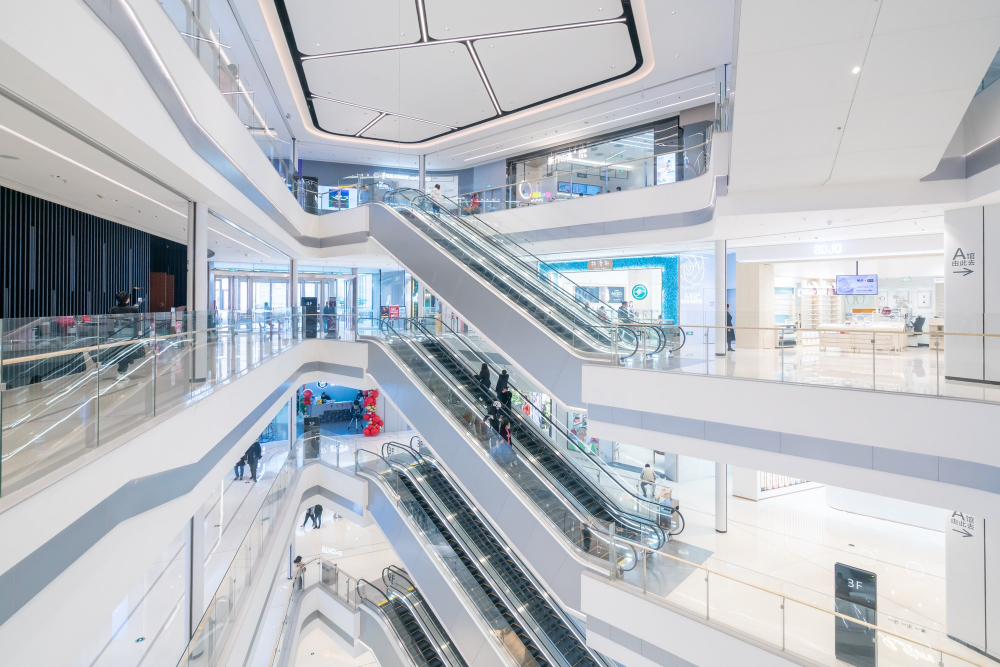Ventilation systems in shopping malls (shopping malls) are important in many respects. First of all, due to the density of people in shopping malls, it is necessary to circulate and clean the air we breathe. The ventilation system performs this function, taking in fresh and clean air, expelling dirty air and removing odors.
Additionally, high heat and humidity levels may occur with the use of shops and restaurants located in shopping malls. The ventilation system increases the comfort of customers and employees by keeping this humidity and heat under control.
 On the other hand, ventilations also play a vital role in case of fire. During a fire, ventilation ducts are kept open to purify smoke and are integrated with sprinkler systems designed to prevent the spread of fire. In this way, fire extinguishing operations can be carried out more quickly and effectively.
On the other hand, ventilations also play a vital role in case of fire. During a fire, ventilation ducts are kept open to purify smoke and are integrated with sprinkler systems designed to prevent the spread of fire. In this way, fire extinguishing operations can be carried out more quickly and effectively.
Shopping malls are closed areas where temperature and ventilation problems may occur. For this reason, shopping mall ventilation has a system designed to clean indoor air, provide fresh air and control humidity.
Shopping mall ventilation systems are generally created using ducts, filters, fans and cooling units. The purpose of the system is to draw in fresh air from the outside, expel dirty air, and control the temperature and humidity of the indoor environment.
However, shopping mall ventilation systems are also known for their complex structures. Therefore, it is important to carry out regular maintenance and cleaning operations. In addition, more modern and smart shopping mall ventilation systems are also being developed and used.
Intake ducts in shopping mall ventilation systems take fresh air from outside and bring it indoors. This clean air is sent to filters where it is cleared of pollutants. The purpose of filters is to provide better air quality by removing dust, pollen and other air pollution elements.
Filtered air is directed towards the interior with the help of fans. Fans help distribute air to interior spaces while also directing airflow toward outlet ducts that allow air to escape from the interior.
Most modern shopping mall ventilation systems are equipped with temperature and humidity sensors. These sensors help measure indoor temperature and humidity and enable or stop the ventilation system. Thanks to sensors, energy savings can be achieved by keeping indoor temperature and humidity under control.
The ventilation system used in shopping malls is a system that has important functions such as providing fresh air circulation in indoor spaces, improving air quality, and keeping the temperature and humidity of the interior under control.
The main purpose of the ventilation system is to reduce indoor pollutants by bringing fresh air from outside inside. These pollutants include elements such as dust, pollen, mold and bacteria.
In addition, thanks to humidity control, problems such as mold and fungi that may occur in case of high indoor humidity are prevented. By measuring indoor temperature and humidity through sensors in ventilation systems, the ventilation system is not operated unnecessarily.
Shopping mall ventilation systems are produced in different models and features. These systems are designed according to the size of the shopping malls, the structure and needs of the interior space. Some common ventilation system models and features include:
It should be taken into consideration that each of these models has different features and should be selected according to the needs of the shopping mall. For example, while a fixed volume system may be sufficient for a small shopping mall, more advanced systems such as chillers or VRF are required for a large shopping mall.
The ventilation systems of shopping malls consist of four main elements: inlet ducts, filters, fans and outlet ducts. Additionally, modern shopping mall ventilation systems may have additional elements such as temperature and humidity sensors.
Sensors help measure indoor temperature and humidity, enabling ventilation systems to activate or stop. Thanks to these sensors, indoor temperature and humidity can be kept under control and energy savings can be achieved.
In shopping mall ventilation systems, the installation phase begins after needs analysis and design. In the needs analysis, the requirements of the shopping mall are determined and its existing infrastructure is examined. Components such as inlet ducts, filters, fans and outlet ducts are placed and tested.
After the installation is completed, temperature, humidity and air quality should be checked by testing the ventilation system. After these adjustments, the operation of the system is optimized by making some special arrangements. System maintenance should be carried out regularly.
Central ventilation systems in shopping malls require regular maintenance and repair work. The frequency of these studies depends on the size of the system and the intensity of use. Periodic maintenance is recommended, usually twice a year.
Maintenance work includes cleaning or replacing filters, checking fans, adjusting the tension of motor belts, cleaning heating and cooling coils. Repair work covers the elimination of faults that occur in the system. Malfunctions usually occur in fans or motors.
In the supply of shopping mall ventilation systems, the selection of appropriate components and the use of quality materials are very important. Therefore, reliable suppliers should be preferred in system procurement.
Additionally, it is important that the supplier has after-sales technical support services. Technical support is required during the installation, testing and commissioning of the system. The technical support team can help with any problems that may arise during and after installation.
You can check out ERF Group for your shopping mall ventilation system needs. ERF Group manufactures and sells industrial fans. In order to find the right solutions for your needs, you can contact company officials via erfgroup.com and get detailed information and price quotes.